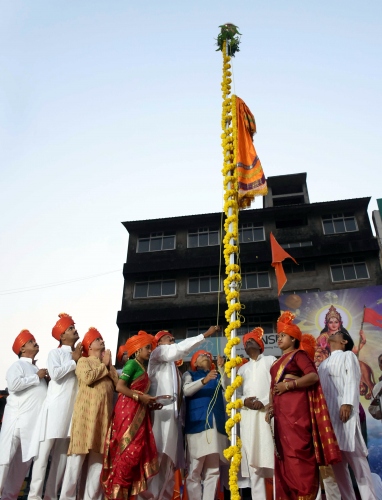Gudi Padwa is a spring festival celebrated mostly in Maharashtra and Goa on the first day of the Chaitra month on April 13. Gudi Padwa is derived from two words, Gudi, which means flag or emblem of Lord Brahma, and Padwa, meaning the first day of the phase of the moon

FR APOLLO CARDOZO S J
Gudi Padwa marks the beginning of the New Year according to the lunisolar Hindu calendar. Being an auspicious day, many entrepreneurs inaugurate their new plans on this day.
Historically, the Gudi symbolises Lord Rama’s victory and happiness on returning to Ayodhya after slaying Ravana. As the symbol of victory is always held high, so is the Gudi (flag). It is believed that this festival is also celebrated to commemorate the coronation of Rama post his return to Ayodhya after completing 14 years of exile.
ORIGIN
A number of stories have been associated with the festival. It is believed that on this day Lord Brahma created the Universe and hence, this day is of special importance for the Hindus. It is also said that on this day, Brahma introduced days, weeks, months, and years.
Hindus worship Lord Brahma on this day because according to the Brahma Purana, the lord recreated the Universe after raging Diluvium in which all time had stopped, and also killed all the earth’s inhabitants. Time restarted on Gudi Padwa, and so too the era of Satyayuga, the era of truth and justice.
CELEBRATIONS IN GOA
Gudi Padwa, also the New Year, is celebrated all over Goa with religious and social celebrations. People start Gudi Padwa with a bath in special oils and aromatics, after which they wear new garments specially purchased for the occasion. They greet each other ‘Happy Gudi Padwa,’ (Happy New Year).’
Women and children work on intricate Rangoli designs on their doorsteps – the vibrant colours mirroring the burst of colour associated with spring.
HOISTING OF GUDI FLAG
The hoisting of the Gudi is the most important ritual of this celebration. The Gudi flag has to be raised at the door keeping in mind certain conditions. The selected area for raising the Gudi is first cleaned, and a Swastik rangoli drawn on the ground. Turmeric and vermilion are offered at the centre of the Swastik. While raising the Gudi, the Shiva-shakti principle in the universe is invoked. Then, the Gudi flag, garlanded with flowers, mango and neem leaves, topped with an upturned silver or copper vessel, is installed in front of their houses.
The Gudi symbolises the Sushumna Nadi of our body. Hence, the Gudi is raised at the entrance and kept tilted at an angle. The spot selected is on the right side of the entrance (when facing outwards from the entrance of the home), which symbolises the active state of the soul.
Once the flag is erected, people offer prayers to Lord Brahma. The locality comes together at this point to perform a special ritual which is the breaking of a coconut kept in the Gudi by forming a human pyramid. This is done only by the men, and adolescent boys. This structure is scaled by one man or a boy who climbs to break the fruit.
The Hindus eat a special mixture consisting of bittersweet leaves of the neem tree or a paste which is prepared with neem leaves, jaggery and tamarind. It symbolises the fact that life is a mixture of good and bad, happiness and sorrow, and that it should be accepted together with equanimity through the New Year.
Special food is prepared on this day, including a sweet known as Shrikhand that is consumed with pooris. Other special dishes include Pooran Poli (sweet Indian flatbread), Soonth Panak and Chana.
Gudi Padwa is a symbolic celebration of love and devotion between wife and husband, so parents invite their newly married daughter with her husband for a meal. Various cultural dances like Ghodemodni are performed on this day.
Hindus believe that this is the best time to start new ventures, be it in business, marriage or house construction. Celebrations in Goa are more concentrated in the Sanguem, Sattari and Gaondongrim areas.
(The writer is former director of Thomas Stephens Konknni Kendr at Porvorim)